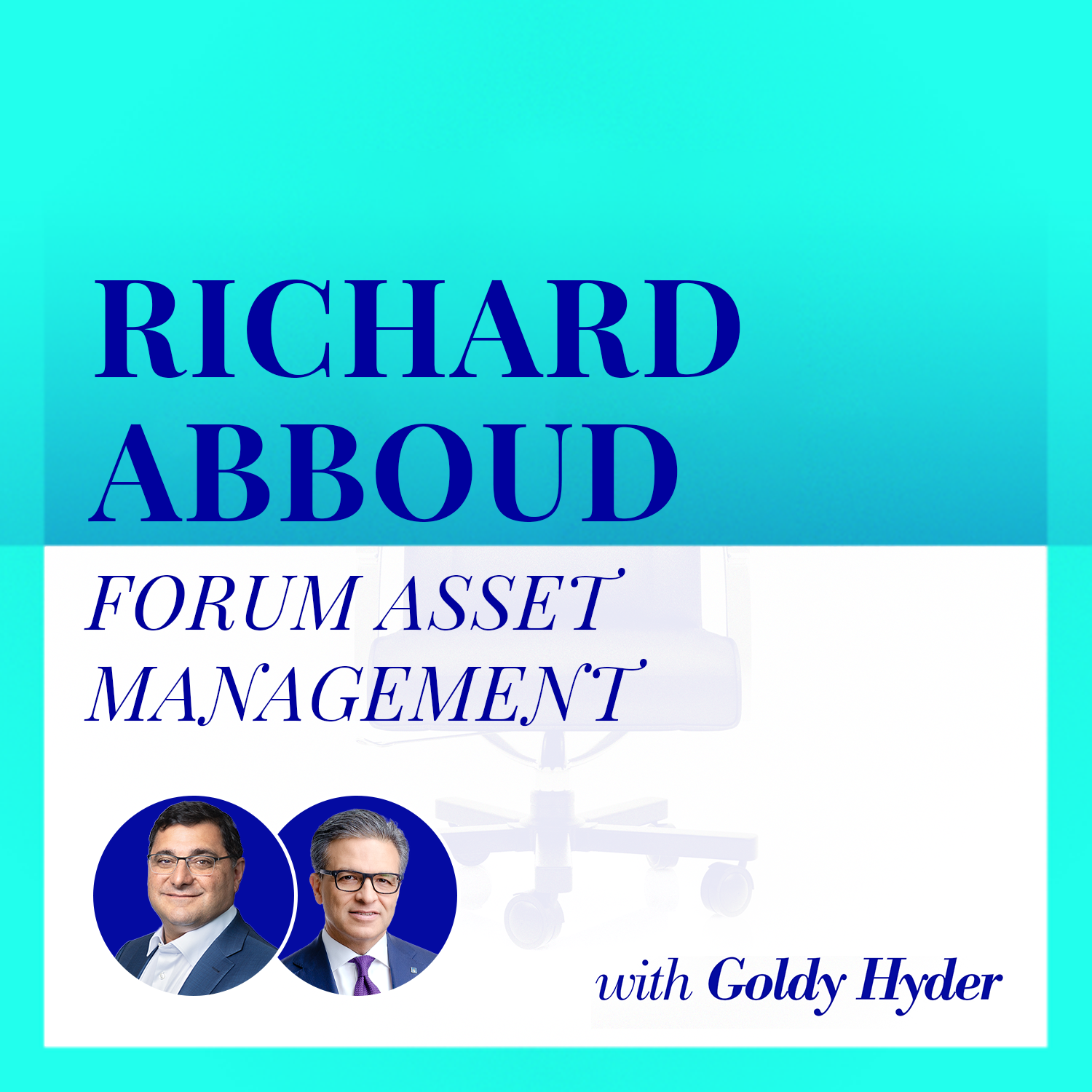How can Canada be an energy leader in a world demanding both growth and sustainability? It’s a question Cenovus Energy CEO Jon McKenzie is seized with every day.
“When I think about the Canadian energy industry and what we are and where we’ve been and where we’re going, I think the opportunity is immense,” he tells Goldy Hyder on the Speaking of Business podcast. “This is an industry that Canada competes on at a global scale.”

Canada is among the top global producers of oil and gas yet faces mounting challenges.
From stalled projects and shifting regulations to the need for ecological sustainability, McKenzie lays out the tough realities as well as the opportunities. He describes it as a “grand bargain” which balances growth, environmental responsibility and regulatory stability.
“There needs to be a coming together of those three legs under the stool and have this grand bargain where everybody is compromising, everybody is of the place where they understand what the end game is, which is to improve our standard of living as Canadians and to increase our economic benefit as a country.”
🎧 Tune in for a sharp, insightful look at the future of Canada’s energy sector.
Jon McKenzie:
Canada is undertaking an experiment as it relates to energy policy where there is no template as to what’s been done before as we are trying to do something that no other major energy producer has done and that we’re trying to really balance the need to grow the resource with the ability to get projects done with the need to respect our environmental aspects of producing energy.
Goldy Hyder:
Welcome to Speaking of Business, Conversations with innovators, entrepreneurs and leaders. I’m Goldy Hyder, president and CEO of the Business Council of Canada.
I say this often, but it bears repeating. Canada has what the world wants and needs. Whether it’s food, innovative technology or resources, our country can feed and fuel the world, and Canada’s energy sector stands at the forefront. Not only does it power our country and much of our economy, but it’s increasingly sought after by countries looking for stable and reliable sources of energy. But what will it take to meet Canada’s full potential? It’s a question I asked Jon McKenzie, president and CEO of Cenovus Energy. The Calgary-based company produces oil and natural gas for use in Canada and around the world. I spoke with John in October in front of an audience at the Toronto Global Forum, hosted by the International Economic Forum of the Americas. Here’s our conversation.
I thought that what I’d have you do for this audience here is to just give us a big picture assessment. We have a prime minister who’s saying this is a hinge moment for our country, that we can do more for ourselves than anybody can do against us. What do you see as the opportunity for Canada?
Jon McKenzie:
First of all, thank you for having me. It’s great to be in Toronto. I left Calgary last night and it was minus five and snowing.
Jon McKenzie:
I’ll speak largely to the energy industry, because that’s an industry that I know it, but I certainly think that the application is broader than that. But when I kind of think about the Canadian energy industry and what we are and where we’ve been and where we’re going, I think the opportunity is immense. So this is an industry that Canada competes on at a global scale. So we are the fourth-largest producer of oil in the world. We produce over 5% of all the barrels produced in the world, and similarly on natural gas, we produce about 5% of global natural gas. The other thing I would suggest or I would say is that has a benefit for everybody in Canada. This is an industry that in 2024 contributed about $40 billion in taxes and royalties, and that goes directly into supporting the lifestyle and standard of living of all Canadians.
And similarly, we invested about $50 billion in capital, which supports about 900,000 jobs in Canada. So on any scale, the Canadian oil and gas industry is on a global comparative with anybody and certainly a large part of the Canadian economic and social fabric. Over and above that, we have the third-largest resource in the world. So we’ve got an opportunity to be a long-term supplier, reliable supplier, economic supplier to global energy as it continues to grow. I think one of the things that a lot of Canadians don’t understand is the demand for energy over the last 60 years has grown by 300%, and it’s going to continue to grow going forward.
And we as a country and we as a global partner are going to need all forms of energy going forward. Whether it’s solar, wind, natural gas, oil, coal, or the like, all forms of energy are going to be needed. Canada is a top 10 producer. It is probably the most stable jurisdiction, producing the most responsible, reliable and economic energy globally. It should be a big piece of that. So I think that’s really our opportunity, Goldy. It’s an industry that’s growing. I think the rumors of its demise have been grossly overestimated, but we as a country have an opportunity to get behind this and move this forward. And I think that’s what the world is looking for us to do.
Goldy Hyder:
So what stands in the way? What is it that’s holding us back?
Jon McKenzie:
The long and short answer is, it’s us. I’ll talk a little bit about this in a little bit more detail, but Canada is undertaking an experiment as it relates to energy policy where there is no template as to what’s been done before as we are trying to do something that no other major energy producer has done and that we’re trying to really balance the need to grow the resource with the ability to get projects done with the need to respect our environmental aspects of producing energy. And I think for the last 10 years, we’ve been really focused on the environmental side to the detriment of building projects and growing our resource. And I think we have an opportunity now to rebalance this, and I think that there’s a grand bargain to be had. And we’ve written letters to the Prime Minister Carney, and 96 or 95 CEOs signed this letter most recently, where we do talk about the grand bargain and the ability to balance those three legs under the stool to the benefit of all Canadians and the global community.
And I think the first thing that we have to realize is anytime we talk about balancing, it means there has to be compromise and that there has to be a recognition that there are no silver bullets, there is only trade-offs. And we need to understand that, we need to respect that and we need to kind of think about that. So when I think about those three legs under the stool, something I’d point about Canadian energy, when it comes to resource growth, it’s been largely stifled over the last 10 years. When you look at the Canadian oil and gas industry, it continues to consolidate. We continue to see global players leave because their capital is better applied elsewhere. So we saw the European companies like Total, like BP, and to a lesser degree, Shell leave. We’ve seen most of the American companies leave, and what we’re really left with is a concentrated group of Canadian companies, but those companies have been placed in a position where they need to live within their cash flow.
There is no incremental capital market capital that’s coming in by and large, and there’s very few startups. So what we’ve really seen is a hollowing out of the industry into kind of five or six big companies on the oil side, two or three or four large companies on the natural gas side. So the ability to continue to attract capital has been something that has been wanting for the last 10 years because of the focus on the environmental side. Similarly, when we look at major projects, Goldy, it’s been really difficult over the last 10 years to get major projects done. So we’ve been in a world where there were 18 proposed LNG projects, all of which were shelved, none of which were done. And luckily, we had a second chance with the LNG Canada project, which is now up and running, to get one LNG project done in Canada.
Over that same timeframe, we had three pipeline projects be canceled that would’ve taken our product to world and global markets as well as Eastern Canada. Even the TMX project that was done, it was originally scheduled to be done by private enterprise by Kinder Morgan, but at the end of the day, they walked away from it in frustration. It took our federal government to pick up the pieces and get that project across the goal line. But it’s been very, very difficult in this world to get major projects done.
And then on the environmental side, I think we have some of the most stringent regulation in the world, particularly for a top 10 oil and gas producer globally. We’re the only country that has a carbon tax in the top 10 producers. We’re the only country that’s contemplating a carbon tax. We’re the only country that has the same kind of methane regulations, tanker bans, and that could go on and on and on.
But we’ve seen a stacking of policy that is intended to protect the environment but has the impact of driving capital way and not allowing capital formation to grow the industry, and then regulatory policy that doesn’t allow us to build things. So there needs to be a coming together of those three legs under the stool and have this grand bargain where everybody is compromising, everybody is of the place where they understand what the end game is, which is to improve our standard of living as Canadians and to increase our economic benefit as a country, but it really does require us to get out of our own way. So I started answering your question with a very short answer and came with a very long-winded answer.
Goldy Hyder:
Well, you’ve answered several of my questions now. So let me go at it with another thought here, which is there is a new leadership in Canada, fair to say he is well-known to the business community, much more pragmatic in his approach, demonstrated that with this decision on carbon tax on the consumer side, which many would not have assumed he would’ve ever done. A lot has been said. Certainly Bill C-5 and its passage with the support of the opposition was intended to address some of the issues that you’ve raised. Are you saying that that’s insufficient, that where we are is insufficient for companies like yours to make final investment decisions to deploy shareholder capital in Canada to build infrastructure?
Jon McKenzie:
I would say it’s probably necessary, but insufficient. And one of the things we have to realize is that we didn’t just arrive in this situation six months ago when Prime Minister Carney took office. This has been a series of events and a series of policy decisions that have been made over 10, 15 years that have got us into the place that we are today. So this is not going to be resolved overnight. We’re not going to suddenly put in a projects office which is going to lead to private capital immediately coming back into the sector and alleviating our problems as it relates to resource growth and getting projects done. One of the things that we’ve been really, really clear with Prime Minister Carney on, and I refer back to some of the letters that have been written to him and supported by a number of CEOs across Canada, is we have to have policy and regulatory reform.
We have to recognize that we as a country and we as an industry, we have to compete globally for capital. And if we can’t be in a world where we can compete effectively and we can bring private capital into Canada, we’re not going to solve the problems that ail us today. So one of the issues I think anybody would see immediately with the projects office is this is an exercise where the federal government is picking and choosing which projects are going to be done. That is not in my mind the role of government. The role of government is to create the conditions necessary for private capital to come in and allocate capital properly so that the projects that we need to get done and the growth that we need to see can actually be done by private enterprise and not with public funds, but for the benefit of the citizens of Canada. So I think we’re headed the right direction and that we’re trying to pivot back to addressing those three areas that I talked about, but I think it’s insufficient right now.
Goldy Hyder:
There’s two ways to skin that cat, right? Then they may say we’re trying to break the logjam of having nothing built or having to nationalize something to get it built, like the pipeline. Major projects office comes in, yeah, we’re going to pick some projects. We’re just trying to create some momentum, change the frame that Canada can build things and that you can invest and you can get projects complete. The other way is of course what you’re saying, which is just create the conditions and you get out of the way. Is there a risk that the approach that’s being taken now in fact creates capital to form around the projects that have been identified and then not go into the other 150 projects that maybe the country still needs from an infrastructure perspective?
Jon McKenzie:
I think that’s right. If you kind of think about projects, they don’t happen in isolation. One of the big projects in my province that gets talked about, it’s not one of the projects that’s in or been prioritized by the projects office today, is a pipeline, and how do we get pipelines built to give us the ability to-
Goldy Hyder:
I knew that would come up in this conversation.
Jon McKenzie:
Give us the ability to get our product to either the U.S. or to Tidewater or to global markets more broadly. Well, pipelines don’t happen in isolation. If you build a pipeline, you actually have to have something to put in the pipeline. So if you’re going to build a million barrel a day pipeline to the West Coast, you actually have to have oil and gas to put in it so that you’ve got something to transport. And if you’re going to do that, we also need more electricity. You need the power to run a pipeline and you need to create all the conditions precedent to fill it. When I kind of talk about needing comprehensive structural reform of our regulatory framework and policy environment, that’s what I’m talking about. And I think you’re quite right to say if we’re going to talk about a project in isolation, we’re missing the bigger picture, because projects don’t happen in isolation. They happen as part of a bigger ecosystem that has to be nurtured with what I think is responsible legislation, a responsible regulatory environment.
Goldy Hyder:
Now, the government is suggesting that in their state as a minority, the best that they’re going to be able to do is have you work around things like the tanker ban, Bill 69 and the cap. Is that going to unleash the capital? Are you going to be able to go to a board for final investment decisions and say, “We’re going to just have to trust?”
Jon McKenzie:
The short answer is that, I’m trying to find a politically correct word to say no, that maybe no is the right word. One of the things that we think about as a country or a company, and we think about when we allocate capital, is when we allocate capital, we’re typically spending money with the expectation that we’ve got a project that’s going to take X number of years to build, and it’s going to be in the ground for X number of years. We’re going to make technology decisions today that we’re going to live with for decades. So what we have to have is some sort of stability, and the political cycle is not consistent with the economic cycle, and we can’t be in a world where we have a change of government and we suddenly have the rug pulled out from us in terms of what we thought was a framework and what we thought was a set of conditions that we made the final investment decision on.
And so that’s very difficult. I think the other thing that I would point out is in industry in general, when we make investment decisions based on promises from various levels of government, that’s a very, very difficult thing to do. Governments change, governments change their minds. Governments have other objectives than making sure that they follow through on a set of promises or even a set of promises that they can’t necessarily deliver on. So when we think about how we allocate capital, we don’t just look at Canada. We look at the U.S., we’ve got operations in Asia, we’ve got operations in other parts of the world, and the capital that we allocate has to compete with those other parts of the world. And unfortunately, political promises don’t carry an awful lot of weight in terms of how we need to allocate capital over a full investment cycle.
Goldy Hyder:
Boy, if there’s one thing that’s predictable, it’s the behavior of capital, isn’t it?
Jon McKenzie:
Yeah.
Goldy Hyder:
I want to help the audience also understand because there’s this perception, old industry, cowboys and the whole bit, the perceptions from Dallas, the show, but there’s a lot of cool things going on in the industry in terms of innovation and leadership. Talk to us about this project called Pathways that people hear about, but I don’t know how many people out here understand. What are you trying to do? And remind them that, not a business case here for this, but why are you doing it?
Jon McKenzie:
Well, I’ll talk about Pathways, but you raise a really interesting point about technology, and we do, I think fight a perception in the oil and gas industry that we are a bunch of Luddites and people see the industry probably the way it was 50 years ago. But I think the oil and gas industry is actually Canada’s high-tech sector. We employ more engineers, more PhDs than any other sector in Canada. And just a proof point that I would give you is oil and gas companies are deflationary machines, and we find more and more and better and better ways to produce the products we produce at a lower and lower cost. And if you look at kind the price of oil in real terms, it reflects that. The price of the commodity goes down in real terms year after year. When I started in this business, and it was 1992, we were producing oil for about six to $8 a barrel Canadian.
Well, today we’re producing oil for about six to $8 per barrel Canadian. We have beaten back 32 years of inflation, and it’s all on the back of technology. So when I look at what our resource development and production people do on a day-to-day basis, I’m just continually amazed. We’re drilling wells today that are two and a half kilometers long, and there’s a window of tolerance that’s two feet by two feet, and they know exactly where they’re putting that drill into the orebody and they know exactly what they’re doing when we put steam underground. But that’s kind of beside the point. But I do think it is a really interesting world, and I do think of our oil and gas sector as being Canada’s high-tech sector, which I don’t think many people perceive to be true.
As it relates to Pathways, one of the things that I think we’re being asked to do as a Canadian industry, and again, nobody else in the world is doing this. No other major producer is doing this. We’re being asked to decarbonize our barrels.
So about 20% of the CO2 that is emitted from a barrel of oil comes from the production and refining of a barrel of oil. 80% comes from the combustion of a barrel of oil. So what we as an industry did is we recognized that we were being asked to decarbonize what we call scope one and scope two emissions and come up with a commercially viable way of doing that. And the Pathways project, and I think this is again unique to Canada, not just that we’re doing this, but because our oil and gas industry is so physically and geographically concentrated with large emitting sources that aren’t dispersed, we’re able to at sort of a larger scale than anybody has done in the world, contemplate building a capture and sequestration hub in Alberta. We have all the right geology, all of the right geography, and all of the right technology.
So this is something that we have been working with the federal and provincial government for probably about five years now to try and create the conditions precedent where through time, this is an industry that will capture and sequester tens of megatons of our emissions. So if you kind of look at oil sands today or the Canadian oil and gas industry, we’re about 25% of Canada’s emissions. This is a way that we can actually decrease that significantly by capturing and sequestering them. So what we’re talking about is building a pipeline that would have the ability to sequester about 72 megatons of CO₂ and put that in the earth and sequester it for posterity so that this never gets back into the atmosphere. Now, the issue with this is one, it’s very expensive. So building these projects, if you think about one megaton, a rule of thumb is kind of $1.5 billion Canadian to build the infrastructure necessarily to capture and sequester this. And then you’ve got operating costs on top of this. And there is no revenue for this.
Goldy Hyder:
No customer.
Jon McKenzie:
There is no customer, there is no revenue. This is something that has only costs, both capital and operating costs. And what we have said as an industry is between the five largest oil sand companies, we’re 95% of oil sands production, which is about three and a half million barrels a day of production. We will pay for some of this, but at the end of the day, we have to be competitive. We cannot put ourselves in a position where we are making ourselves uncompetitive for the Exxons, with the Shells, with the Totals and the BPs, the companies that we actually compete with on a day-to-day basis.
We can pay for some of this, but we can’t pay for all of this due to its scope and magnitude. And so what the ask has been is from the federal and provincial governments, we’re looking for 75% compensation on capital, the industry will pay the other 25%, and then we would pay 33% of the operating costs, and we’d need to be subsidized for the other 66%. But if we as a country want to lower our emissions and really tackle our climate change obligations and commitments, this is probably the least painful way to do it. But it can’t be done by industry alone. So keeping the industry competitive, allowing it to grow and getting infrastructure done that gets us to markets is what we call that grand bargain, the three legs under the stool. And we would have a view of the Pathways is a really important piece of this, but we all have to be really clear as to what this is and how it has to be set up in the financial framework to make it happen.
Goldy Hyder:
In the two minutes we have left, I want to end on with two quick questions. One deserves a topic all by itself, but I know you care passionately about this and are leaning in. What role is industry playing on economic reconciliation with our Indigenous groups, and how important is that as we go forward?
Jon McKenzie:
I think it’s incredibly important, and I think the industry has, we’ve really moved forward over the last 20 years, and I think we’re really doing things differently, and I think we’ve really embraced the idea that First Nations economic reconciliation is something that we need to undertake, and it’s just good business. It’s very similar, I think, to the safety motive that permeated through this industry in the early part of the century. As a company, maybe I’ll start as an industry, we’re the largest employer of First Nations people across Canada, the oil and gas industry is, and the people that work in our industry make significantly more than those that don’t. So part of economic reconciliation in my mind is very synergistic with what we’re trying to do as oil companies, is we’re taking people that actually live in the areas that we produce oil and gas, and we’re taking that latent source of labor and we’re employing it to the benefit of both.
Above and beyond that, as a company, and I know other companies are doing this, Suncor, CNRL, Tourmaline, some of the bigger companies across Canada, we help First Nations get industry started or businesses started, and then we employ them and we use them as part of our day-to-day operations. So we will spend billions of dollars with First Nations companies as well as employing people. But I think the most satisfying thing that we have done as a company, and I can’t take credit for this. This was my predecessor, Alex Pourbaix, who started this. We started a First Nations housing program where we made a commitment that we were going to spend $50 million to build 200 plus homes for First Nations, and really address the crisis at the grassroots level.
And we’ve been, through the last five years, we built, I think the number’s getting close to the 200 today, but we’ve recently announced that we’re going to renew that program and do more of this. But what we found through time is having good First Nations partners is really important to the industry. They’re good advocates for the industry, they benefit from it. And when you have the opportunity to do things at a grassroots level like what we’re doing with our housing program, there is nothing that we have done as a company that improves the morale across the company like we’ve seen with this First Nations housing program. So, it’s been a real benefit to the company on a number of different fronts.
Goldy Hyder:
Well, look, we’re over time. I do want to end on a positive, optimistic note. One thing I know from you and the chief executives I have the privilege of working for is you’re eternal optimists. Despite everything you’ve just said, you’re an optimist. What’s your hope for Canada and for your kids as we look forward?
Jon McKenzie:
I’ve got five kids, so I have a lot of hopes.
Goldy Hyder:
A lot of bills too.
Jon McKenzie:
Yeah, I have a lot of bills there. And one thing I’ll tell you, for anybody who’s got small kids, it only gets more expensive as they get older. It doesn’t end at 18 like you may have hopes and dreams of.
One of the things I think, Goldy, is when I think about measuring success, none of us occupies a position or occupies a place in perpetuity. We’re all just borrowing where we are. And I think success always looks like leaving it in a better place than we found it. And one of the things I would hope, and I’m not sure we’re headed in this direction today, but I hope when we leave this world for our kids, that we leave it in a better condition than we found it. When I think about myself at 18, 19 years old, and I was thinking about what I wanted to do, the world was my oyster, and we didn’t have 14% youth unemployment.
We didn’t have declining GDP, we didn’t have an affordability crisis. I bought my first house with my wife for $82,000. But what I hope is that we can come together as a country and we can really think about the way we want this world or our country to be left for our kids and how we’re going to set them up for success and how we’re going to give them the values and structure that they can leave on this country to their kids in a better condition than they found it. But if we can do that, in my mind, that’s success and that’s my hope.
Goldy Hyder:
What a great note to end on. Ladies and gentlemen, Jon McKenzie. Thank you.
Jon McKenzie:
Thank you.
Goldy Hyder:
Jon McKenzie is the president and CEO of Cenovus Energy. I spoke with him in October in front of an audience at the Toronto Global Forum. If you’ve missed any of our Speaking of Business conversations, you can catch up by subscribing to our podcast. Search for Speaking of Business wherever you get your podcasts, or check out our website where you’ll find photos and other content from our conversations. Just go to thebusinesscouncil.ca/podcasts. Speaking of Business is a production of the Business Council of Canada. Our thanks this month to the International Economic Forum of the Americas, and we couldn’t do this podcast without Will McIntyre and the team at Pop-Up Podcasting in Ottawa. Until next time, I’m Goldy Hyder. Thanks for joining us.









